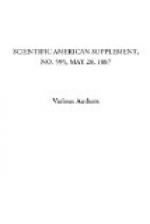A very interesting experiment was performed at Filey, in June, 1870. A breeze was blowing from the sea, and had been blowing for 12 or 15 hours. Mr. Blackley flew his kite to an elevation of 1,000 feet. The glass attached to the kite was exposed for three hours, and on it there were 80 grains of pollen, whereas a similar glass, exposed at the margin of the water, showed no pollen nor any organic form. Whence came this pollen collected on the upper glass? Probably from Holland or Denmark. Possibly from some point nearer the center of Europe.
POTATO DISEASE.
A study of the terrible disease which so often attacks the potato crop in this country will serve, I think, to bring forcibly before you certain untoward conditions which may be called climatic, and which are attributable to fungoid spores in the air.
With the potato disease you are all, probably, more or less practically acquainted. When summer is at its height, and when the gardeners and farmers are all looking anxiously to the progress of their crops, how often have we heard the congratulatory remark of “How well and strong those potatoes look!” Such a remark is most common at the end of July or the beginning of August, when the green part, or haulm, of the plant is looking its best, and when the rows of potatoes, with their elegant rich foliage and bunches of blossom, have an appearance which would almost merit their admission to the flower border. The same evening, it may be, there comes a prolonged thunder storm, followed by a period of hot, close, moist, muggy weather. Four-and-twenty hours later, the hapless gardener notices that certain of his potato plants have dark spots upon some of their leaves. This, he knows too well, is the “plague spot,” and if he examine his plants




